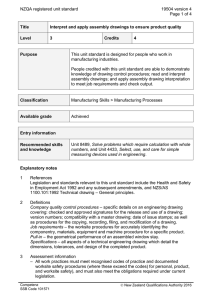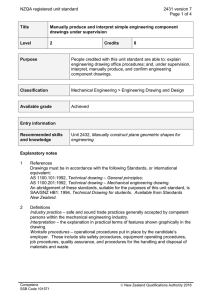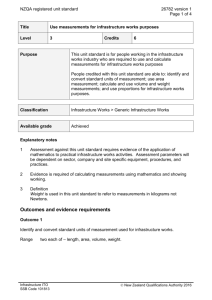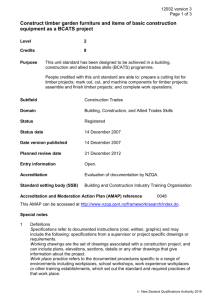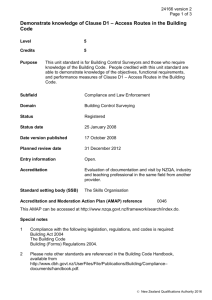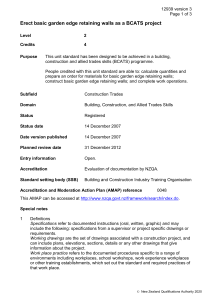26331 Interpret heating, ventilating, and air conditioning
advertisement
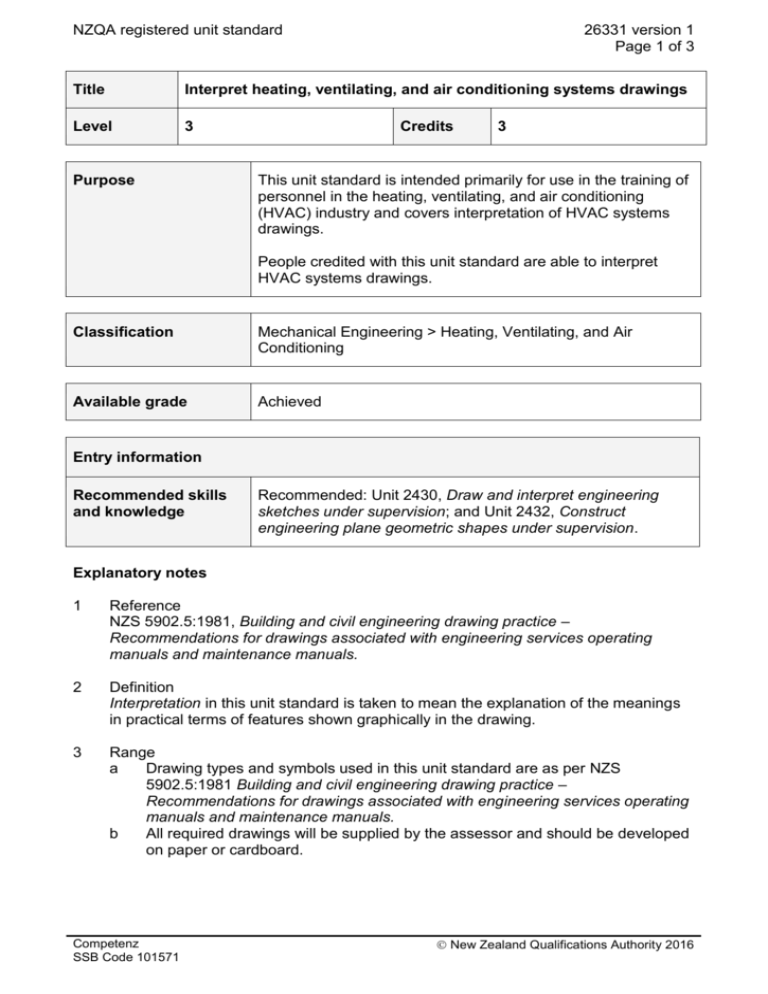
NZQA registered unit standard 26331 version 1 Page 1 of 3 Title Interpret heating, ventilating, and air conditioning systems drawings Level 3 Purpose Credits 3 This unit standard is intended primarily for use in the training of personnel in the heating, ventilating, and air conditioning (HVAC) industry and covers interpretation of HVAC systems drawings. People credited with this unit standard are able to interpret HVAC systems drawings. Classification Mechanical Engineering > Heating, Ventilating, and Air Conditioning Available grade Achieved Entry information Recommended skills and knowledge Recommended: Unit 2430, Draw and interpret engineering sketches under supervision; and Unit 2432, Construct engineering plane geometric shapes under supervision. Explanatory notes 1 Reference NZS 5902.5:1981, Building and civil engineering drawing practice – Recommendations for drawings associated with engineering services operating manuals and maintenance manuals. 2 Definition Interpretation in this unit standard is taken to mean the explanation of the meanings in practical terms of features shown graphically in the drawing. 3 Range a Drawing types and symbols used in this unit standard are as per NZS 5902.5:1981 Building and civil engineering drawing practice – Recommendations for drawings associated with engineering services operating manuals and maintenance manuals. b All required drawings will be supplied by the assessor and should be developed on paper or cardboard. Competenz SSB Code 101571 New Zealand Qualifications Authority 2016 NZQA registered unit standard 26331 version 1 Page 2 of 3 Outcomes and evidence requirements Outcome 1 Interpret HVAC systems drawings. Range interpretation from a supplied drawing or number of drawings. Drawings include – ducting drawings, mechanical services layout, piping arrangements, schematics, block schematics. Evidence requirements 1.1 Drawing concepts used in supplied drawings are identified. Range 1.2 Different types of lines are interpreted. Range 1.3 visible at low level, visible at high level, concealed at high level, concealed at low level, vertical concealed, vertical visible, external. Different types of pipe and ducts are interpreted. Range 1.4 concepts may include – scale, third angle projection, first angle projection, isometric drawing, oblique drawing. round, square, uninsulated, insulated. HVAC system components are identified by sight and associated information interpreted. Range system components may include – cooling towers, air handling units, cooling and heating coils, fans, furnaces, pumps, dampers, filters, compressors, condensers, chillers, thermostats, controllers, sensors, diffusers, evaporators, valves, meters, grilles, ducts, air drives, fan coil unit. Evidence of 15 components is required. Associated information may include – air flow, water flow, pipe pressure, component manufacturer’s designations, directional characteristics. Status and review information Registration date 16 July 2010 Date version published 16 July 2010 Planned review date 31 December 2015 Accreditation and Moderation Action Plan (AMAP) reference 0013 This AMAP can be accessed at http://www.nzqa.govt.nz/framework/search/index.do. Competenz SSB Code 101571 New Zealand Qualifications Authority 2016 NZQA registered unit standard 26331 version 1 Page 3 of 3 Please note Providers must be granted consent to assess against standards (accredited) by NZQA, or an inter-institutional body with delegated authority for quality assurance, before they can report credits from assessment against unit standards or deliver courses of study leading to that assessment. Industry Training Organisations must be granted consent to assess against standards by NZQA before they can register credits from assessment against unit standards. Providers and Industry Training Organisations, which have been granted consent and which are assessing against unit standards must engage with the moderation system that applies to those standards. Consent requirements and an outline of the moderation system that applies to this standard are outlined in the Accreditation and Moderation Action Plan (AMAP). The AMAP also includes useful information about special requirements for organisations wishing to develop education and training programmes, such as minimum qualifications for tutors and assessors, and special resource requirements. Comments on this unit standard Please contact Competenz at qualifications@competenz.org.nz if you wish to suggest changes to the content of this unit standard. Competenz SSB Code 101571 New Zealand Qualifications Authority 2016
